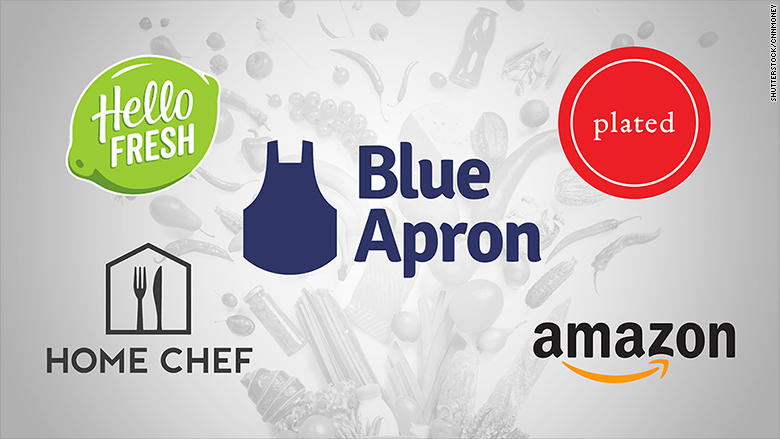
Disclaimer: We hope you're hungry for food puns, because there are a lot in this story.
Are home-cooked meals a recipe for success or disaster in the tech industry? We're about to find out.
Blue Apron, a service that mails you a box of fresh, pre-measured ingredients with the recipe included, is nearing an IPO that is expected to value the company at around $3 billion -- or even more if there's enough investor appetite.
The public offering is the first from a much hyped new market. Startups like Plated, HelloFresh, Sun Basket and Home Chef have each raised tens, if not hundreds, of millions in private capital to make meal subscription services mainstream.
If that's not enough, Amazon (AMZN) now has the potential to eat Blue Apron's lunch too. With its pending deal to buy Whole Foods (WFM) for $13.7 billion, Amazon could upend the grocery shopping experience online and in stores.
The Blue Apron IPO and Amazon's grocery splurge highlight the growing importance of food in Silicon Valley. Suddenly there's billions at stake to change the way we shop for groceries.
It also shows how unpredictable the competitive landscape can be. This month, it's Amazon shaking everything up. Next, it could be Google (GOOGL) or Uber, both of which have experimented with grocery deliveries.
"You are hard-pressed to find a market that is as big as the food market. It's massive," says Woody Marshall, a partner at Technology Crossover Ventures who has invested in Spotify, Netflix (NFLX) and Airbnb.
CB Insights, a data and research firm, divides the meal delivery market into two sectors: businesses that deliver prepared meals and those that deliver groceries.
The latter group, which includes Blue Apron, Instacart and others, received $1.4 billion in funding last year, according to CB Insights. Now Blue Apron will offer the first taste test for this group on Wall Street -- and the initial feedback is less than inspiring.
Related: What happens to Instacart in the Amazon-Whole Foods deal?
It's "not a financially healthy company," says James Gellert, CEO of RapidRatings, which rates the financial health of public and private companies. "I can't really think of a reason they should go public other than someone should be first and they've probably decided they should be first."
Blue Apron's sales hit nearly $800 million in 2016, more than doubling from the year before, according to its IPO paperwork. Unfortunately, that growth rate is slowing and Blue Apron is bleeding more money than ever.
The company lost about $55 million last year, up from $47 million a year earlier. Much of that loss is likely driven by the cost of marketing. Blue Apron invests in TV commercials, outdoor ads, countless podcasts and promotional offers to continue growing its customers base.

The problem for Blue Apron and its competitors is that none has cornered the market yet. So each company may be forced into a endless war of discounts and aggressive promotions, not unlike the ridesharing wars between Uber and Lyft.
"I actually don't think the market has matured enough to the point where a customer is saying, 'I'm going to use Blue Apron over HelloFresh.' It's too new," Marshall says. He met with each of the top companies in the space, but has so far declined to invest in any.
Blue Apron faces an added challenge: managing a supply chain. It must source, store and deliver fresh ingredients, creating logistical and food safety issues that set it apart from other recent tech IPOs like Snapchat (SNAP).
If that challenge wasn't daunting enough, Gellert says Blue Apron may now have to compete against "the buying power and logistics might" of the ultimate supply chain giant: Amazon.
Blue Apron doesn't mention Amazon or its other competitors by name in its IPO filing. But it does note that "business combinations and consolidation" in its industry could "result in competitors with significantly greater resources and customer bases than us."
By going public now, Blue Apron may boost its brand recognition and get more funds to compete for customers and talent. Its head start may not last for long, though.
HelloFresh, an international operation with more than $350 million in funding, has reportedly also flirted with going public. Chef's Plate, a startup based in Canada, is planning an IPO in the next year or two.
"If Blue Apron does really well over the next year... you are going to see people saying, 'Let's see the next public company,'" says Paul Holland, a partner at Foundation Capital who has invested in the food market. He says could be big enough for "three or four" similar publicly traded businesses.
And if Blue Apron's IPO ends up being a flash in the pan? "That's bad news for everybody," he says.

